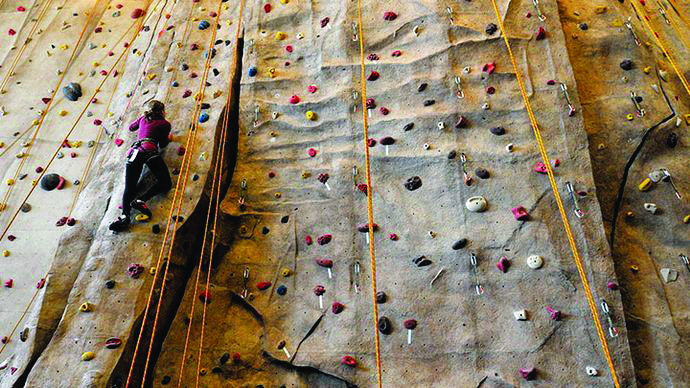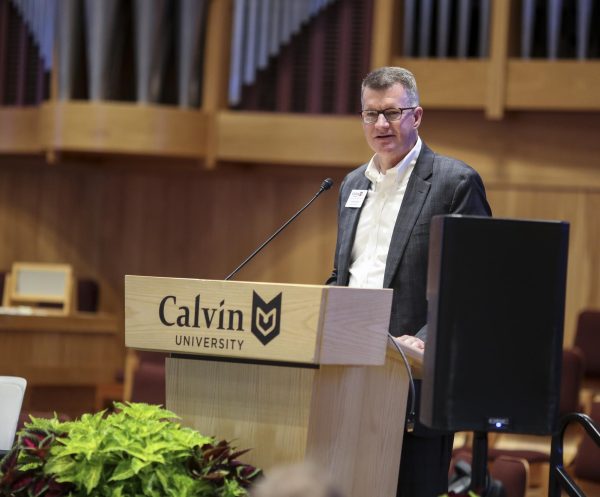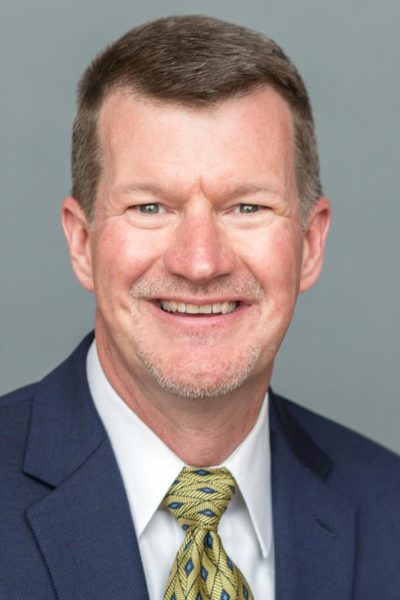The Calvin rock wall: A gripping history
If you’ve ever been in the Spoelhof Fieldhouse Complex, you might have noticed the large wall that rises up from the lower lobby to be the front-and-center view of the complex. What you might not know is that Calvin almost did not have a rock wall.
When Ryan Rooks, Calvin’s campus recreational coordinator, came to Calvin 14 years ago, the first course he was responsible for was a climbing class. At that time, Calvin did not yet have a climbing center, so he constructed the class using a local gym called Inside Moves. The class would also take weekend trips to climb outside at places like Grand Ledge, Mich.
For the first six to seven years that he taught the course, Rooks would try to get at least 25 students to purchase a six-week unlimited climbing pass for Inside Moves. The main problem they had to contend with was transportation. Rooks would organize Calvin vans or buses to ferry all the students to the gym at least once a week. Otherwise, students would have to drive themselves if they wanted to go more often.
The class would culminate in an outdoor experience where they would use advising break to take a trip to Red River Gorge in Kentucky, where they would camp and climb together. The class eventually built up to having 40-50 people each fall.
This was the model that climbing culture at Calvin was first structured around: one class for each semester.
The outdoor recreation staff was very active and did a lot of planning for weekend trips and summer programs that went beyond the climbing course. Rooks trained the staff via an interim class that he has led since the second year he came to Calvin: the Grand Canyon Outdoor Educator.
On this interim students get a ten-day medical wilderness first-responder certification through Knolls and the Wilderness Medical Institute (WMI). It includes a seven-day backpacking trip in the Grand Canyon, with leadership curriculum, and finishes with seven days in Joshua Tree, Cal. where students complete a rock climbing instructor course.
“This was an interim that built the leadership base in getting staff certifications and giving training and real world experience … That was an important piece of development that occurred before we had a facility built,” recalled Rooks.
Then, in January of 2009, the Spoelhof Fieldhouse Complex was completed. A few years before the completion of the building, Rook joined the planning and developing committee. Glen Van Andel was the chair of the committee at this time, and he was always passionate about outdoor and open recreation for students that were not athletes. As such, Van Andel was interested in helping Rooks continue to cultivate the climbing culture at Calvin.
Calvin looked at bids from three or four companies for what it would cost to put in a climbing facility. The climbing wall was one of the most debated features of the building, and it was the last activity area to be committed to. Moreover, there were donors who gave for most areas of the building, but none who gave for the construction of a rock wall.
Responding to these difficulties, Van Andel went to the contractors who were working on the building and asked them to give a little bit toward this last project. There is a plaque by the rock wall today that features the names of all the contractors and companies that contributed to the wall.
The facility was built by a company called Entreprise. According to Rooks, this company was chosen because they could get the project done on time and could do so without making the wall out of plywood. Since the wall was going to be in the center of the fieldhouse, The building committee wanted it to look realistic. A product called freeform was used to achieve this.
To enhance the experience of climbing, the wall is based off of actual rock faces. Red River Gorge and Joshua Tree were the two primary locations designers used for the model. Rooks said it was this, among other elements of the wall, that made it stand apart from other climbing facilities at that time:
“One of the features of Calvin’s wall that was truly unique at the time it was built was that we had parallel sided cracks for teaching crack climbing … We also made sure that we had low-angle slab climbing. Most gyms don’t focus on that type of feature. We designed our lead wall, which is the overhung wall, after the predominant type of terrain in Red River Gorge, Kentucky, so that we could teach students to lead climb in a similar setting.”
To gain additional ropes and square footage to the wall, the builders added two vertical plywood wings on the south and north end, which allowed for seven more climbing ropes. They managed to achieve all this within the budget, and the final price tag was around $160,000, making it one of the more cost effective features of the fieldhouse.
The one problem that occurred during the completion of the wall was that the fire marshals needed the mezzanine for the courts across from the wall expanded in order to safely evacuate in the case of an emergency. This meant a late change for the designs of the wall, as the mezzanine was pushed out about eight feet, requiring the overhanging wall to be bumped back, and some swing radius for the wall was lost.
After a year and a half under construction, the wall finally opened in time for the 2009 January interim. When the wall first opened there were questions as to how often it would be used. To the surprise of many, in the first year it was open there were over 15,000 sign-ins.
One of Rooks’ goals for the wall is to make it access-friendly and barrier-free to students. That, in large part, has to do with the staff.
“When I hired and selected staff, I hired them based on leadership ability, their desire to serve our students, to be friendly and hospitable. And I emphasized that we are an educational institution, and so everything that happens at our wall should be educational and people should be able to master skills. Our staff is there to guide that process.”
Rooks wanted the experience at Calvin’s wall to be different from anything he had experienced anywhere else. So rather than having a single staff member sitting at a desk, checking people in, he hired staff to be out on the floor, encouraging climbers and giving out coaching advice.
Rooks wanted to make sure that the wall was open at times that were optimal for every student to be able to go when they don’t have classes. Rooks has identified the ideal climbing times for students to be 3 to 5 p.m., and to 9 p.m.
Although hours have changed over the years, lately they have stayed constant. Groups such as dorm floors or clubs can make requests for the wall to be opened to them for events and retreats, but the open hours of the wall are, for the most part, protected.
Another goal of Rooks’ was to make the wall at Calvin be as engaging and interesting as the most popular gyms in the country. When the facility was still under construction, Rooks was on the phone with 25 different climbing gyms around the country, and he had a set of questions he would ask them.
“There were three variables that would show up in every conversation I would have with these premier gyms around the country. They said that the secret to climbing gym success is a combination of great routes, friendly staff and great music.”
When it came to the routes, they should be changing throughout the year. The way that Calvin does this is having a few head route setters who are proficient at the skill. One route can take an average of two hours to set, and it should have consistent level of difficulty throughout. A route setter’s goal at Calvin is to add two to three routes to the wall a week. At any given time, there are 50 routes on the wall.
Two times a year, the entire wall gets stripped of routes and Calvin invites in route setters from the community to come in and help the staff reset the whole wall with 50 new routes in a week. The whole project, with the help of volunteers, takes about 250 hours. This event is then celebrated with a climbing competition. One is held in the fall, and the other in the spring. This year’s fall rock competition will be Saturday, Nov. 11.
The wall has always had a student manager, currently Laura Vanwinkle, who is administrative in risk management and who has operational responsibilities. Derek Nykamp is the current class manager. He is the one who runs the sport classes and technique classes and helps to TA the PE classes. James Owens is the head route setter.
In all of this, Rooks’ greatest joy “is watching students develop in their ability to lead, manage, instruct, risk-manage, facilitate, and build culture.”








